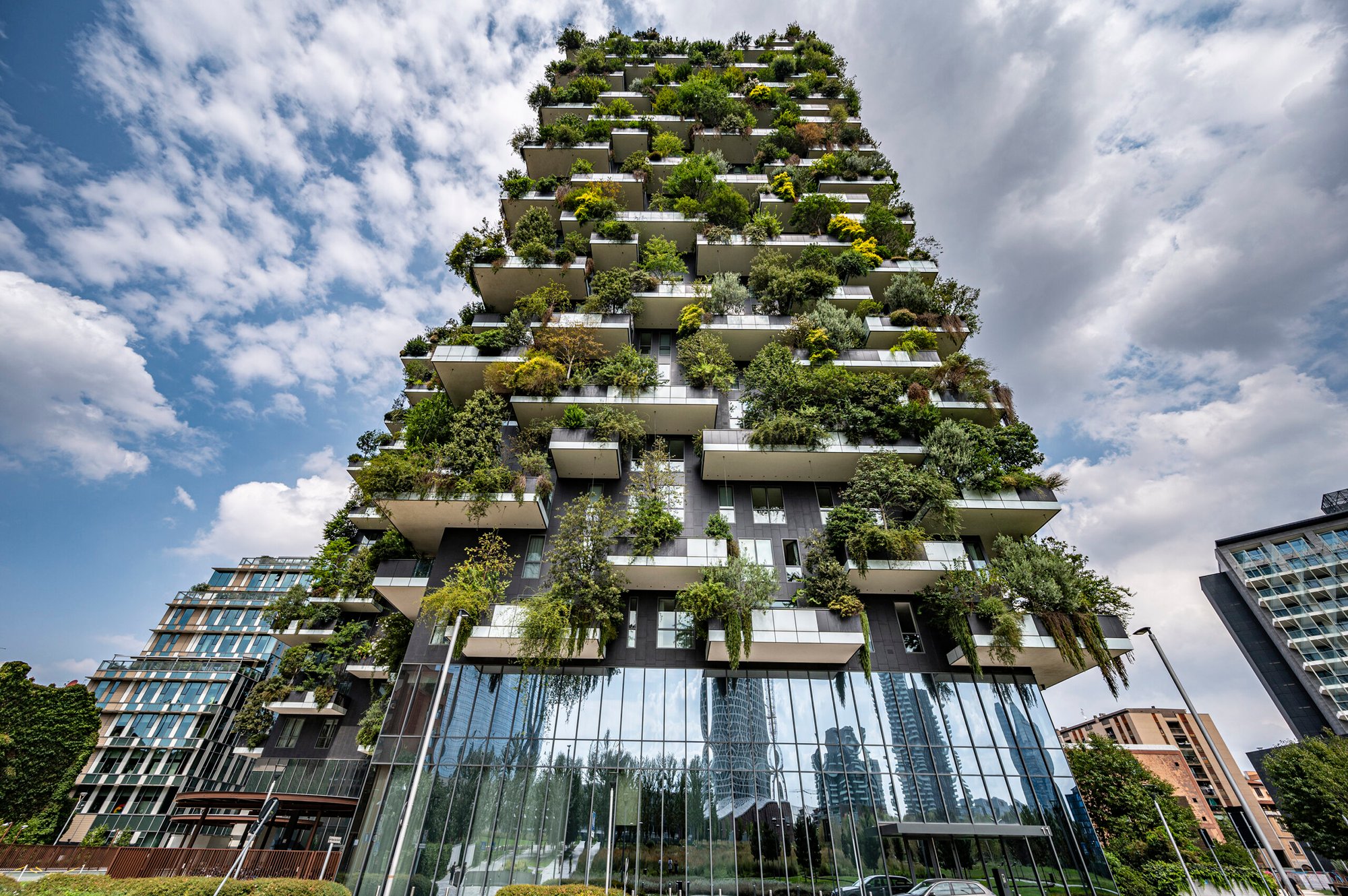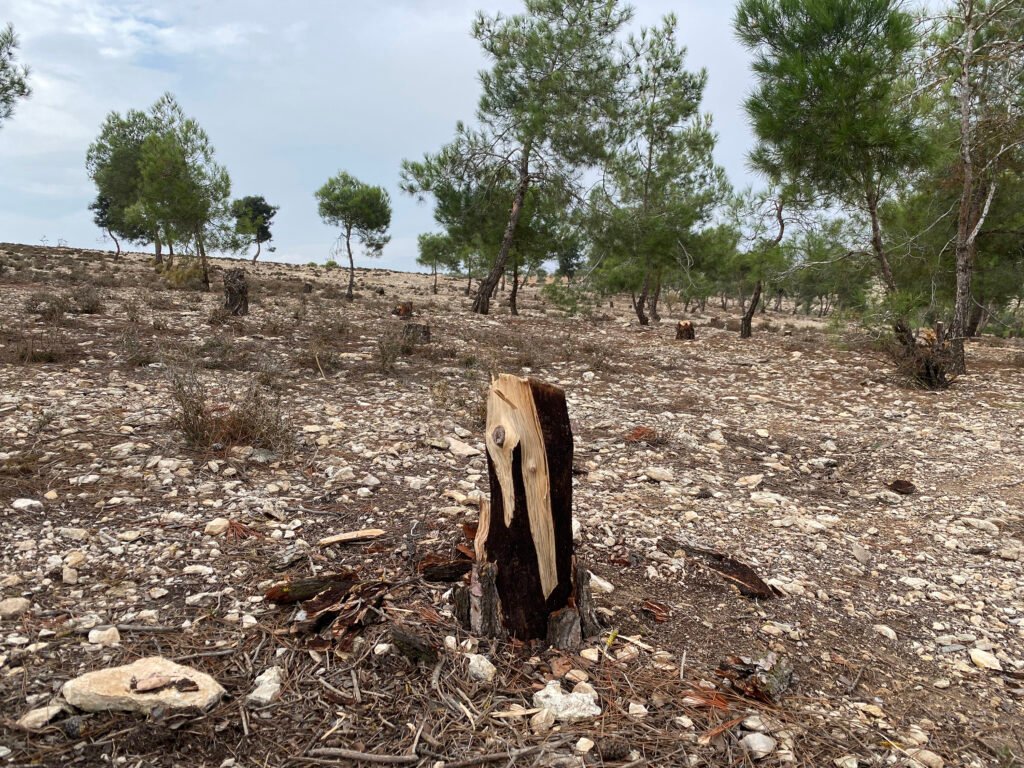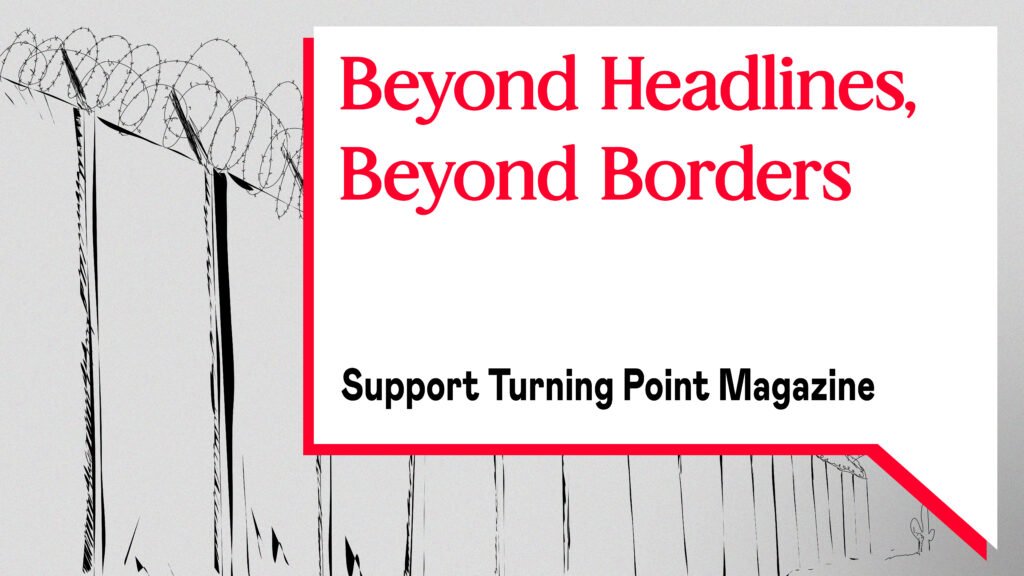Cover photo: Bosco Verticale, a luxury residential skyscraper in Milan, Italy. © detstheway
On August 12, the Italian Ministry of Health declared a “red alert,” the highest degree of health emergency, in 22 cities across the country. The Mediterranean nation struggled to overcome the hottest August in recorded history, with urban temperatures hovering around 40 °C. In Rome, Florence, Milan, and other urban centers, city dwellers were told to stay indoors, hydrate, and turn on their air conditioners.
A red alert is raised when heat poses a fatal danger to everyone, not only to those with known vulnerabilities. However, a major part of the population belongs to at least one of the risk groups, which include elderly people, young children, women, and people with aggravating health conditions. Heat also poses an elevated danger to agricultural workers without appropriate protections, homeless people, and people living in state-neglected neighborhoods lacking public services and support structures.
While this summer broke global heat records, Italy has declared health emergencies every summer throughout the 2020s. Last year, the red alert was issued in nearly all cities, as excessive heat killed an estimated 12,700 people across the peninsula, making Italy the worst affected European country.
In Italy and elsewhere in Europe, healthcare systems do not systematically record heat as the direct cause of death behind heart attacks, organ failures, or other fatal symptoms of heat stress. The mortality estimates come from statistical epidemiological models like the ones run at the Barcelona Institute for Global Health (ISGlobal). A recent study published by the institute estimated that in 2023, there were 47,690 deaths directly attributable to the surging temperatures in Europe. Despite increased floods, forest fires, and droughts awakening many Europeans to the emergency of climate change, heat-related mortality is still clouded with prejudices and uncertainties.
“People are realizing what is going on, but with heat-related death, I think maybe the population is not aware of it,” estimated Elisa Gallo, an epidemiologist at ISGlobal and the lead author of the research on last year’s heat-related mortality in Europe. “We are trying with newspapers, by communicating with people, and by interviews to show people what is going on also from the health perspective; that climate change has an impact on our health.”
According to the World Health Organization (WHO), heat-related mortality in the European region has increased by 30% in the past two decades. Particularly vulnerable are the Mediterranean urban centers where concrete and asphalt accumulate large amounts of heat from solar radiation. Nicknamed as urban heat islands (UHI), built areas in cities like Athens, Rome, and Madrid can suffer temperatures up to eight degrees (°C) higher than their neighboring rural areas.
“In the last years, a lot of efforts have been put to increase green spaces to try to reduce the heat island effect,” said Gallo. “For sure living in a place with more green spaces [puts] you at lower risk of heat death.”
ISGlobal’s earlier study on heat-related mortality estimated that every increase by one Celsius degree causes 18,547 additional deaths per year in the continent. A difference of one degree can thus be a question of life and death for thousands when soaring summer temperatures test the limits of humans’ heat resilience.
With the recent trend of “green cities,” “carbon neutral cities,” and “smart cities,” municipal policy-makers worldwide have taken action to combat global warming or at least adapt to the dangers of increased heat and other calamities that changing climate brings to their constituencies. The past years have vividly demonstrated how a simple natural element—trees—can radically ameliorate cities, making them a key ally for humans in keeping their urban habitats livable. Recent advances in ecological engineering have brought new life to the old debate on whether a city can truly be “green,” or if urban greenery merely veils an inherently unsustainable organization of modern metropolitan life.
Turning Point talked with municipal officials, grass roots organizers, researchers, and residents in the Middle East, Europe, and the Americas to map out urban strategies for adaptation to climate change and to find out more about the prospects of finding an alternative to the current, ecologically devastating forms of urbanization. The whole story begins in Medellín, Columbia.
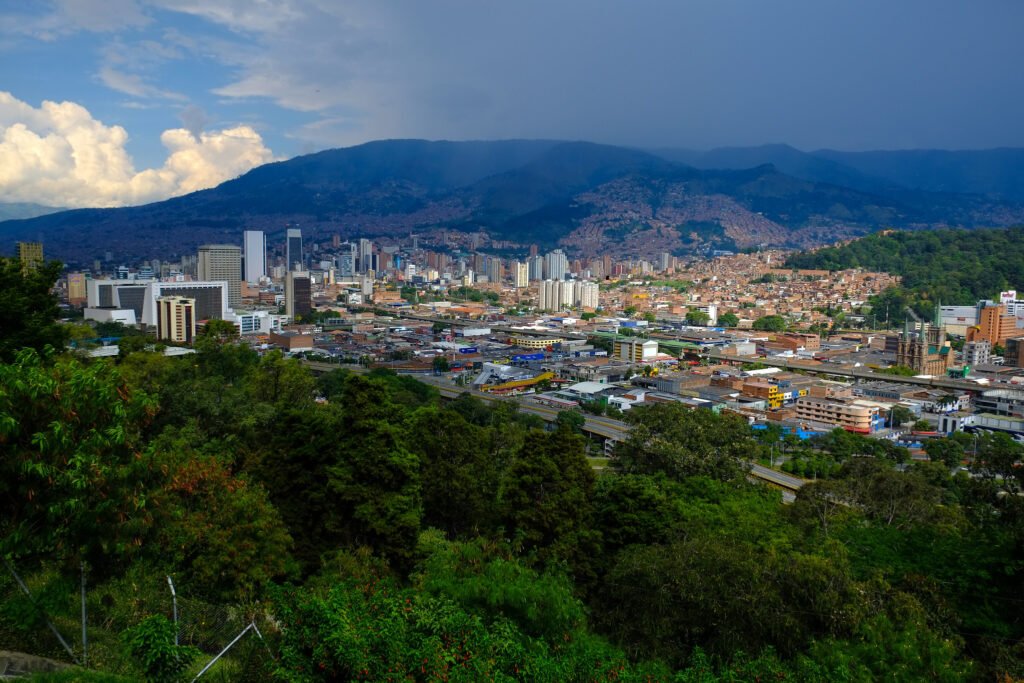
Medellín, Columbia
During the past half-decade, Medellín has been studied as one of the global pioneers of green urban planning. The city’s development has been widely scrutinized and publicized in scientific journals, newspapers, and environmental magazines.
Home to 2.6 million people, Medellín is seated in the Aburrá Valley in northwest Columbia, 1,496 meters above sea level. With the surrounding mountains trapping air inside the valley, the greater metropolitan area has suffered from fatal levels of air pollution. In the peak years 2015 and 2016, air pollution by fine particulate matter could easily exceed 55 µg/m3, more than 11 times the WHO-recommended safe levels (5µg/m3).
Fine particulate matter, or PM2.5, refers to airborne particles less than 2.5 micrometers in size. The connection between PM2.5 exposure and direct, potentially fatal health complications, such as chronic respiratory diseases and lung cancer, is well-established. According to the WHO, outdoor PM2.5 pollution causes up to 4.2 million premature deaths per year worldwide, making it the top environmental hazard for humans.
Researchers at Medellín’s University of Antioquia estimated that in 2016, PM2.5 pollution caused 2,004 deaths in the Aburrá Valley—roughly one person dying every four and half hours in the region. The same study projected the annual toll to triple to 5,867 deaths by 2030, while estimating that the fatalities could be halved with effective “control strategies” in place. Medellín turned to a natural remedy: trees.
What started in 2016 with the planting of some 12,500 trees and 120,000 plants on the roadsides and parks turned into an ambitious urban vegetation program. By 2021, the city had planted 880,000 trees and 2.5 million smaller plants across 30 corridores verdes, green corridors that pierce the city along its major streets and waterways. The corridors are meant to mimic forests with dozens of plant species at low, medium, and high altitudes. Each plant has been studied for its “ecosystem services.”
Some plants, like mango trees (mangifera indica), thrive in polluted environments and are excellent at absorbing the fatal PM2.5 particles from the air. Others shine in absorbing large quantities of CO2, the leading greenhouse gas, or in creating large canopies to provide shade and reduce the urban heat island effect. In addition to the green corridors, buildings are also included in the program, starting with the City Hall which now hosts nearly 100,000 plants of 12 different species. Vines and other climbers, vertical gardens, and “green roofs” are guarding many of the city’s concrete constructions from direct sunlight and heat absorption. The results have been encouraging.
During the program’s first three years, the metropolitan area recorded more than a 2 °C decrease in air temperature attributable to the new urban design. Surface temperatures decreased by up to 10 °C inside the corridors. In 2019, the city was rewarded for its efforts with an Ashden Award in the “Cooling by Nature” category. The project’s proponents say that the city is expected to see a further drop by 4-5 °C in the coming three decades, basically erasing the urban heat island effect altogether.
Besides cooling down the city, Medellín’s green corridors have provided a myriad of other benefits that researchers are following closely. One study estimated that just one of the 30 corridors would absorb 160,787 kilograms of CO2 annually. At the same time, cycling in the city has reportedly increased by 34,6%, presumably reducing transportation emissions. In another corridor, a group of biologists identified 30 previously unseen species of butterflies, showcasing the rapidly increasing urban biodiversity.
With air pollution, the city has recorded an almost immediate effect. Since 2020, local air pollution levels have been in decline, reversing a two-decade upward trend and finally pushing the numbers below the Colombian norms (25µg/m3) last year. While the city’s annual PM2.5 levels are still several times above the WHO recommendations, the figures are not unusual for contemporary urban centers. In fact, the WHO notes that “almost the entire global population (99%) breathes air that exceeds WHO air quality limits, and threatens their health.”
Medellín’s new urban design has proposed an organic, effective, and cheap way to cool down a major metropolitan area while reducing the city’s carbon footprint and pollution. The initial investment for the municipality-led project amounted to $16.3 million, and the newly extended green areas have added $625,000 in annual maintenance costs to the municipal accounts. The figures are orders of magnitude below the project’s environmental and health benefits, and generally modest for a metropole whose GDP stands at $72.6 billion.
According to research at the University of Antioquia, between 2010 and 2016, only the direct economic costs of the suffering and deaths from PM2.5 pollution totaled about $281 million in the region. That is, more than 15 times the cost of the new green corridors. While most indicators, such as increased biodiversity and population health or decreased temperature and carbon footprint, cannot be assigned a monetary value, there has been little room for economic arguments against the project. One of the metropoles inspired by Medellín’s example is Milan.
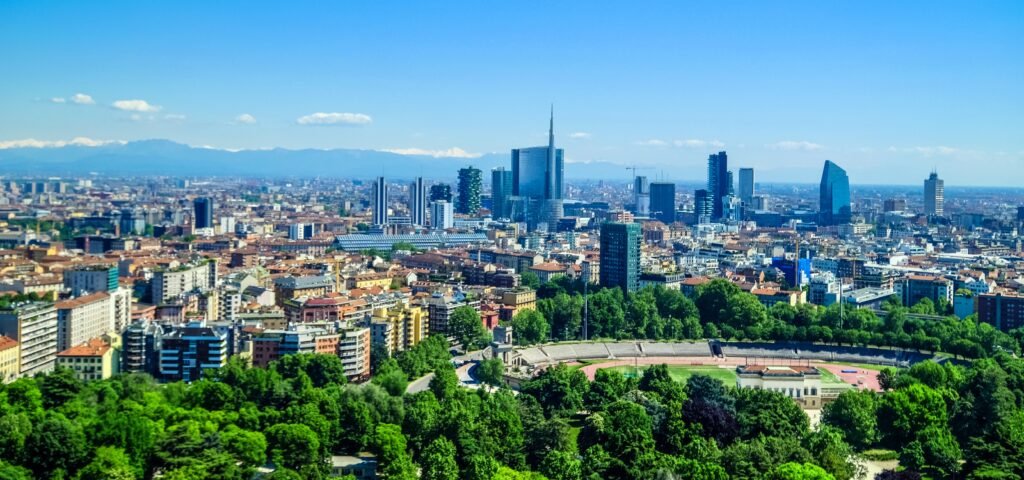
Milan, Italy
Located in the upper Po River Valley in northern Italy, the metropolitan area of Milan hosts approximately 3.25 million people. Similar to Medellín, the surrounding mountain ranges – the Alps and the Apennines – prevent strong horizontal winds around the city. Combined with the historical concentration of heavy industries in the region, the lack of airflow makes Milan’s surroundings and Po Valley in general one of the most polluted areas in Europe. Recording daily PM2.5 levels as high as 24 times above the WHO limits, a Swiss air quality monitoring company IQAir ranked Milan as the third most polluted city in the world at the beginning of this year.
In 2019, municipal and provincial authorities launched a metropolitan reforestation program in collaboration with the Polytechnic University of Milan. Listing Medellín as one of the global role models, the ForestaMi program aims to plant three million trees across the Milan metropolitan area, roughly one for each inhabitant. The proponents of the campaign envision it as a national reference point for Italy, eventually expanding to an effort of planting 22 million trees in all the 14 metropolitan zones of the country in tandem with other regional and national initiatives.
The campaign website reports 427,475 trees planted so far, but the concrete impact remains unquantified. Only around 25,000 trees have reportedly been planted in the city area of Milan, roughly equal to the City Council’s annual routine planting. The rest have been planted in quasi-urban and rural areas across the wider metropolitan territory.
“For me the number [3 million trees] is big, but I am not aware where they are putting the trees,” said Ilaria Zappitelli, a biologist and chemical specialist at the Italian National Council of Research (CNR). While not affiliated with the ForestaMi program, Zappitelli has researched the potential of urban vegetation in comparative studies of different tree species and different cities in Italy, also in Milan.
Zappitelli and her colleagues have categorized more than 600 tree species according to their ecosystem services, e.g. the ability to remove specific pollutants. To achieve effective results, she said, the trees must be planted close to the source of pollution: “In the city it is the best, as you can see from the maps that the pollution is in the center of Milan.” At the same time, she explains some of the complexities behind their calculations.
“It is important to consider allergies, for example. […] Cypress is a species that sequestrates a lot of CO2, but most of the population is allergic to it,” she said about urban forestation. Their research has shown some cypress species absorbing up to seven times more CO2 per square meter than typical Milanese trees, such as the Mediterranean hackberry (celtis australius).
Another factor to consider are so-called biogenic volatile organic compounds (BVOCs) that trees can emit in large quantities. BVOCs are highly reactive organic molecules that can profoundly alter the atmosphere’s chemical properties.
“They are pollutants because these molecules produce ozone in the atmosphere,” said Zappitelli. Produced primarily by airborne BVOCs, ozone is the third most important greenhouse gas. On the ground level, it also causes significant direct damage to vegetation.
Zappitelli said their research group tries to include more factors into their models, ranging from mental health benefits and pollution removal capacity to BVOCs, allergies, and other potentially harmful side effects. Finally, climate change itself must be added to the equation.
“Until two years ago, I was thinking that we should plant only Italian or European species in our environment. But the climate is changing so we cannot protect these species,” she cautioned, saying that already some native species struggle to survive. “I have to choose something that works better in this new climate.”
Currently, Zappitelli and her colleagues are expanding the tree database to include species from 25 European countries. The database will become accessible through a free mobile application by the end of the year. Currently in its testing phase, the Airtree application will enable users to identify trees via image recognition and review their ecosystem services. Or in reverse: by inserting data about the specific local pollutants, the user can receive suggestions of species that can effectively ameliorate the local habitat.
While promising a policy recommendation tool for urban planners, the application may also inspire individual residents and civil society to take action in urban greening. While collecting significant support from private enterprises such as Amazon, Armani, and the supermarket chain Esselunga, the ForestaMi campaign appears to lack popular momentum in the city. Based on discussions with Milan’s inhabitants, even with generally news-aware and environmentally informed neighborhood organizers, residents are outright unaware of the project’s existence. Instead, the topic of urban greenery has provoked mere mutterings about “Bosco Verticale,” the seemingly controversial landmark of the city’s green ambitions.
Bosco Verticale, or Vertical Forest, is a residential skyscraper in Milan’s Isola district. Inaugurated in 2014, the building won the prestigious International Highrise Award of contemporary architecture for setting an “excellent example of revitalizing an urban center.” For many locals, the skyscraper and its multi-million-dollar apartments represent exclusive elitism that sidelines the city’s actual residents.
“The project could be defined as ‘eco-gentrification’, an even more insidious form of top-down urban development capable to co-opt the desires and demands of the inhabitants and translate them into fashionable slogans that mystify the devastating impact they have on the less privileged inhabitants of those areas,” one particularly fiery letter from Isola neighborhood artists argued as far back as in 2009. Isola is one of the most rapidly and heavily gentrified neighborhoods of Milan. Stefano Boeri, the architect of Bosco Verticale, has later steered the private foundation behind the ForestaMI campaign.
At the same time, the residents of Milan could play a decisive role in greening the city. Many Milanese already cultivate plants on their balconies and yards. A satellite-image analysis has shown that up to 43% of Milan’s rooftops would be suitable for vegetation, but only 3% of the appropriate surface is being utilized so far. According to Zappitelli, only 20% of Milan’s current greenery is administered by the municipality itself (basing this number on satellite image analysis).
The figures imply a great unleashed potential of urban residents who are still uninformed about or alienated by municipality-led efforts or lack participatory mechanisms and resources to become active agents of urban development. To the question of resident empowerment and mobilization, the People’s Municipality of Qamishlo in Syria has proposed a novel model of participatory governance.
Qamishlo, Syria
Qamishlo is located in the northeast of Syria, on the Turkish-Syrian border which separates the wider population center into the twin cities of Nusaybin and Qamishlo. Since 2012, the city of Qamishlo has been de facto self-governed after the northeastern Syrian region declared autonomy from Bashar al-Assad’s government in the midst of the civil war. After linking neighboring territories to the project of regional self-governance, the People’s Municipality of Qamishlo became a part of the wider confederation of municipalities that currently form the Democratic Autonomous Administration of Northern and Eastern Syria (DAANES).
The Qamishlo municipality has pushed forward an ecological transition in accordance with the DAANES Social Contract which sets ecology as one of the founding principles of the self-governing confederation. The conditions on the ground, however, are pressuring the population. While suffering from extreme heat, looming desertification, and soil erosion, the city of Qamishlo also faces a myriad of environmental problems typical to conflict zones, such as the accumulation of waste in urban spaces and ad-hoc landfills that turn into environmental and health hazards. According to Berîvan Omar, a senior municipal official at DAANES administration, air pollution from diesel-fueled cars and household electricity generators is also an increasingly pressing problem.
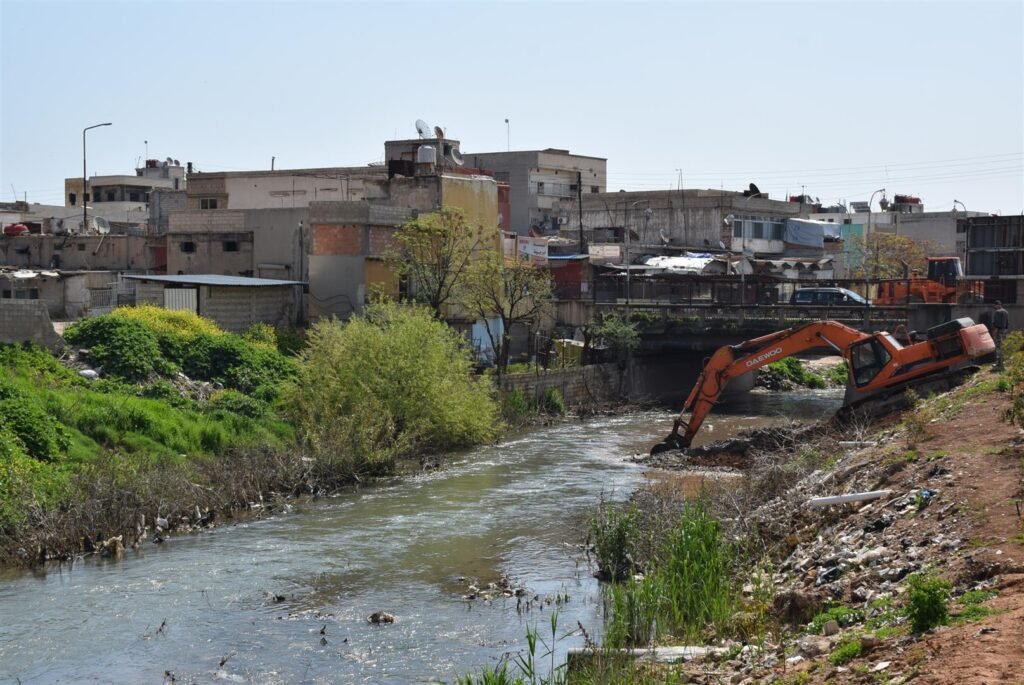
“Finally, the most serious problem in Qamishlo is the contamination of the Caqcaq river that runs through the city and [whose] water has become dirty,” Omar continued. She said the contamination of the river has led to an increase in certain diseases among people living close to the river, and the water contamination affects the whole city.
Omar would like to see the whole Caqcaq River that winds through Qamishlo’s center district turned into a green area by planting trees along its banks. She said the municipality and local NGOs continuously clean the riverbanks, but trash continues to accumulate in the city, and at the riverbanks in particular. Holding a degree in agricultural engineering from the Euphrates University in Hesekeh, Omar knows well how trees could help the city.
“Every year there is a plan for planting trees inside the city and for increasing the urban green areas. For example, last year we planted 3,000 trees inside the city,” she said. “It is not only for the heat but also for pollution that trees play a central role.”
According to Omar, a major limit for urban greenery is the extremely high density of residential buildings, a legacy of decades of modernist urban planning, further aggravated by the high number of IDPs and the lack of urban development regulations during the first years of the revolution. She said the absence of non-constructed spaces seriously hinders municipal efforts.
“The municipality cannot go to the families and force them to plant trees in front of their doors. It is not correct, and a municipality cannot work like that,” Omar said. “Currently we aim to cultivate small forests in the [city’s] surroundings, and the places we chose now are eight kilometers away from the city.”
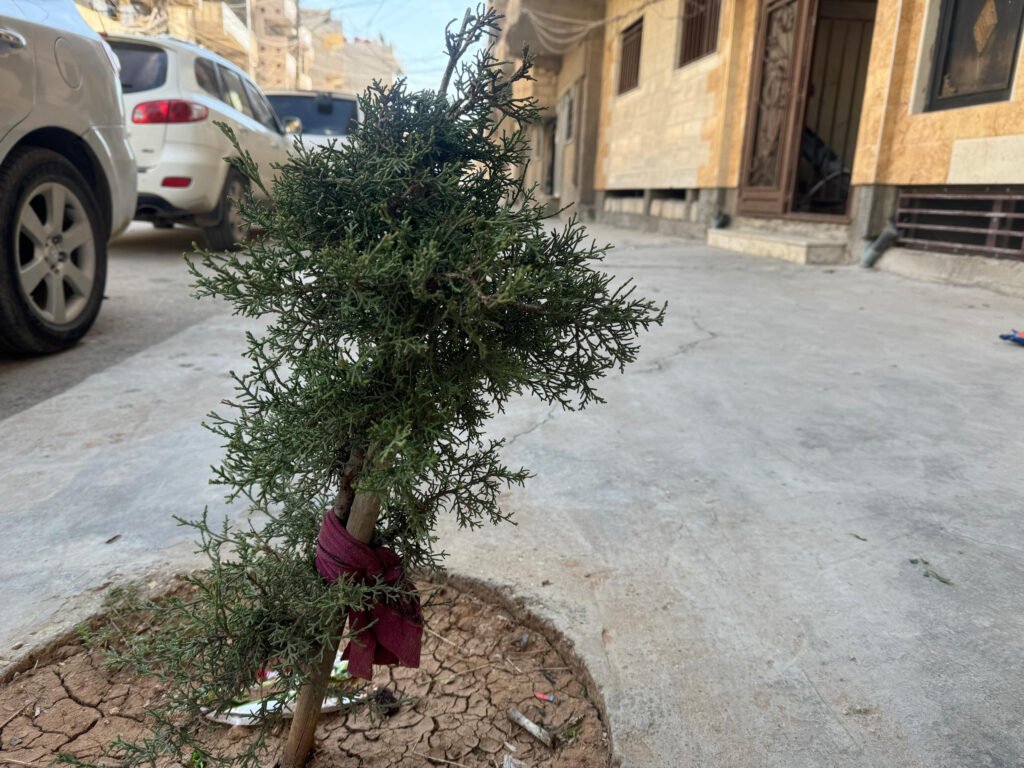
However, the peculiar political organization behind the “People’s Municipality” has provided effective workarounds to the problem. The municipality is interconnected with a wider network of popular structures that can mobilize the residents for common goals and projects. Like all municipalities of the DAANES confederation, Qamishlo is split into several smaller subunits or “communes.” The communes are neighborhood assemblies where a few hundred residential units come together to make collective decisions that concern their quarters.
“As a commune, we set a goal that every family would plant one tree in front of their house […] I wouldn’t say it was not successful, but it was not enough. More trees should be planted,” Omar said about her own neighborhood. While she is currently running as a candidate for the co-mayor’s office, in the commune she is equal with her neighbors. The elections are scheduled to take place in October.
Before starting to campaign for Qamishlo’s co-mayorship, Omar worked as the co-chair of the Municipalities Union for the wider Cizire region. In that capacity, she also sat on the preparation committee that drafted the new Law of Democratic Municipalities which regulates various competencies and procedures of municipal governance structures across the DAANES polity.
The new law re-affirmed on the municipal level the DAANES foundational principle that every executive position is shared between a man and a woman, to enforce gender equality throughout the administration. The principle is visible also in the administrative titles, such as co-mayor or co-president. The law also formalized already existing accountability mechanisms between municipal officials and their constituencies. According to Omar, co-mayors, for example, can be withdrawn from the office if they don’t implement the program assigned to them.
Omar went on to explain how municipal decision-making works in practice as the preparations for municipal projects for the year 2025 are currently underway. First of all, the new law decrees that each municipality must implement environmental programs every year. To decide upon the projects, the municipality of Qamishlo is now conferring a city-wide People’s Assembly where all residents can shape the priorities for the following year. After the assembly, municipal officials will synthesize the proposals into a draft program which will be ratified later this year.
“The co-mayors cannot change the plans or start saying ‘we do this’ or ‘we don’t do that’ […] Once the City Assembly—the people—have reached a formal decision, the co-mayors must implement it,” said Omar. The aim of these mechanisms is to ensure that elected officials remain loyal to the collective will and needs of the neighborhood communes and the city population as a whole.
Besides mobilizing the neighborhood communes, the municipal efforts have been supported by different components of civil society. In accordance with the DAANES’s principles of democratic confederalism, myriad civic bodies and civil society organizations have become direct channels to participate in and influence local governance— some of them having guaranteed seats in the complex web of councils, committees, and other municipal and confederal decision-making bodies.
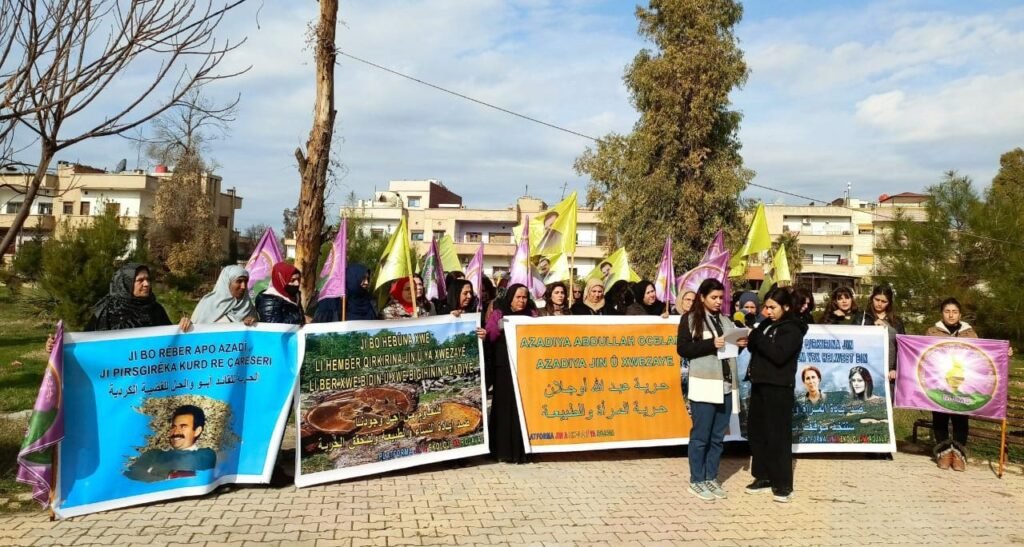
“For example, the Women’s Ecology Platform started a very good campaign last year. We went to all the families [who already had trees] and proposed to plant more trees; at least 3, or as many as is possible for each family,” said Omar who, despite her other responsibilities, is also a member of the platform. “We also went to all families who had empty lots, and the numbers were not bad: we planted at least 1,500 trees [in Qamishlo] in the frame of this campaign.”
In a similar vein, the youth organization of the prominent PYD party planted 200 trees in 2020, while the students of Rojava University planted another 3,500 trees last year. The Caqcaq river was cleaned last year with the efforts of the local PEL association, while another association Green Braids opened a tree nursery in the city, with an ambitious goal to plant 4 million trees in the wider region.
Despite similar efforts springing up all across northeastern Syria, Omar believes the main obstacle to the region’s ecological transformation is still the level of environmental consciousness in the society.
“As much as we clean the city, it always becomes trashed again,” she said without the slightest hint of despair. Pulling yet another ace from her sleeve, she said preparations are already underway to open the first Ecology Academy, a new institution specifically focused on environmental education, to tackle the issue.
Contrary to the “top-down” models of urban planning found in most modern metropoles, Qamishlo has proven a remarkable capacity to mobilize its residents in building their own urban environment for the better. With few resources, the internationally unrecognized and economically isolated confederation has pushed forward an ecological transition while navigating 13 years of war. However, Omar concludes that the war remains a key problem. Northeastern Syria has faced extreme drought and water crisis amid allegations of Turkey weaponizing water in its war against the region.
“For the people, water is the most important thing,” Omar said. “If fathers and mothers don’t have water for their children, they are not willing to cultivate trees.”
Finding a Road That Does Not Lead to Rome
According to an old urban legend, Leonardo da Vinci, perhaps the most famous urban planner and engineer in human history, once went to his patron Ludovico Sforza, the Duke of Milan in the mid-15th century, and candidly advised him to dismantle the capital of his dominion. In place of Milan, da Vinci would have built ten smaller settlements to host the population.
“Separate this great congregation of people who herd together like goats on top of another, filling every place with foul odor and sowing seeds of pestilence and death,” Lewis Mumford, a pioneer of modern urban planning, quotes da Vinci lamenting to Sforza. The Duke did not give in, and Milan has since greatly outgrown its Medieval walls, turning itself into the economic powerhouse of Italy and one of the biggest and most polluted metropoles in Europe.
The moral of the story, according to Mumford, is that the wider cultural shift away from the “Medieval town” represented one of the significant missteps in the development of urban civilization. While breaking away with the Medieval tradition of “human-sized” urbanism, Mumford says, the modern megacities found a role model in the “sprawling metropole” of Rome: the ever-expanding, conquering, and resource-extracting center of power that aims to subdue all its surroundings to its service before turning into a culturally decaying and socially disintegrating “necropolis.”
Are towns and villages the future form of human habitation, or can we envision a new urban renaissance by breaking away from the Roman “imperial tradition”? Do metropolitan congregations unavoidably lead to social disintegration and environmental devastation? Six hundred years later, the conflicting visions of da Vinci and Sforza are still very much at the center of debates about the convivial and sustainable organization of human communities.
“Speaking philosophically, that is a very interesting question that we are discussing at the Institute right now,” said Paul McIsaac, an environmentalist from New York and a member of the Institute for Social Ecology (ISE). The US-based ISE describes itself as an independent academic institute for “popular education for a free and ecological society.”
“There is the argument that if you can put a lot of people into a small space and do it properly, with correct ecological engineering, it is better than taking a lot of land,” said McIsaac. “On the other hand, there is a whole other school that disagrees with this, and says that what we must do is to de-emphasize the [role of] cities and spread them out into the land in a way that they are living more in harmony with nature, that is, closer to pre-industrial or even native societies.”
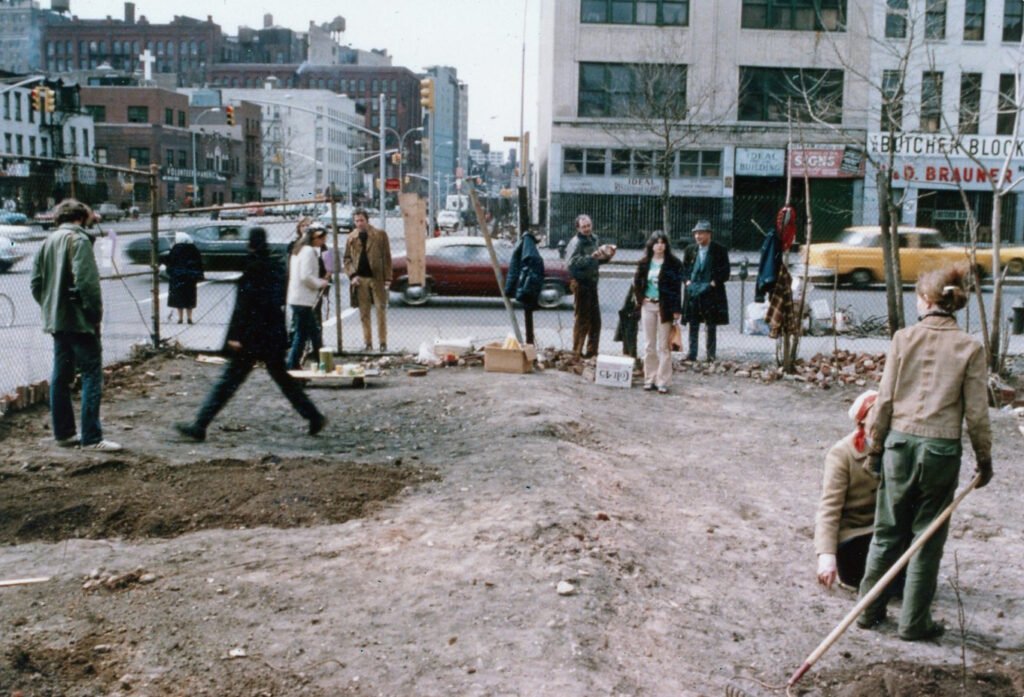
McIsaac started his environmental activity in the early 1970s by producing radio interviews on WBAI-FM, NYC, with ecological thinkers such as Murray Bookchin, E.F. Schumacher, and the above-mentioned Lewis Mumford, but also featuring grassroots organizers like the so-called Green Guerillas of New York— a band of rebel gardeners who used to throw “seed bombs” (seed-filled water balloons) over the fences of vacant lots and occupy neglected and empty spaces for communal gardening. In 1972-73, he hosted a radio show together with the founder of the Green Guerrilla movement, Lizz Christy, as they aimed to spread “the idea of bringing organic nature back into the urban environment.”
“A number of things like that rose from the ground-up, there [were] no party or governmental organizations,” McIsaac recalls the early attempts to re-green the cities. “These are the kind of activities [people] did in the anarchist tradition of the politics of act, the politics of action.”
“Because the influence of real estate is so powerful—particularly in New York—and the land is so highly-priced, the city would not allow anything to happen to these empty lots and put fences to keep people out,” he described the atmosphere in the 1970s. “Urban gardening, which had very different origins of course, has reached a point now that it is accepted much more by local governments.”
In general, McIsaac welcomes the growing acceptance and the shift in institutional urban planning towards greener cities, including the “mega-projects like in Medellín.” However, the veteran environmentalist remains somewhat unconvinced: he sees them as important steps both in slowing down climate change and preparing the cities to face the upcoming climate catastrophes but differentiates between emergency measures and long-term sustainability.
“When someone says it would be great to have more trees in the city to cool the city down, it takes a pretty irrational person to say ‘no, that’s not a good idea,’” he said laughing. Turning immediately more serious, he added: “But do they at the same time develop the social and political commitment to building sustainable communities? That’s the real question.”
In Social Ecology, a social philosophy based on the body of writings of the late American social theorist Murray Bookchin, the question of environmental sustainability boils down to the social relations between humans and the relations between humans and nature. McIsaac said that the ISE places “deeper interest in the human organization, their political and social organization, in relation to questions of food, water, and so forth—and how people organize themselves to make that sustainability possible.”
In their current form, modern cities are still far from the sustainable social organizations that McIsaac and the ISE are looking for. Comprising only 2% of the world’s land surface, urban settlements are estimated to account for 75% of natural resources consumption and two-thirds of energy consumption, while producing up to 70% of global greenhouse gas emissions and 50% of waste. Greener or not, metropoles like Milan and Medellin have not by far decoupled from the rapid population and economic growth and the resulting material consumption growth that drives anthropogenic climate breakdown, air pollution, and biodiversity loss.
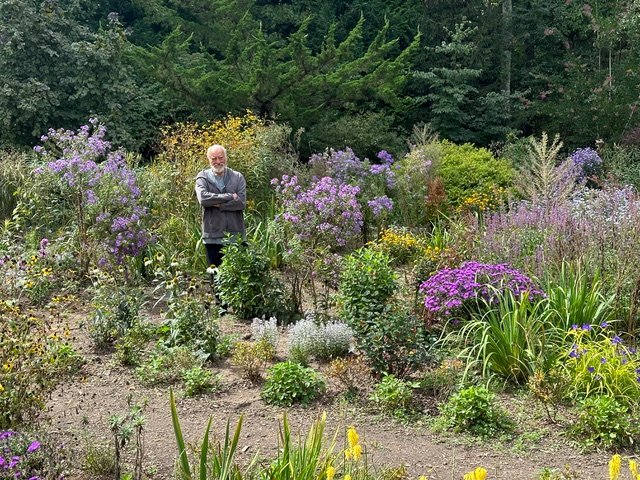
Regarding the question of whether big metropoles can possibly evolve into ecologically sustainable habitats or a movement to smaller settlements is necessary, McIsaac does not have a clear-cut personal answer, although he is familiar with arguments on both sides. “Maybe do both in some ways,” he said, pointing to the urgency of finding tangible solutions.
The United Nations expects the global urbanization rate to rise from the current 55% to 68% by 2050. Combined with the simultaneous overall population growth, the urban population is estimated to increase by 50%. That is, the earth is expected to sustain 2.5 billion more city people in the next 25 years, making the connection between urbanization and ecology one of the most pressing questions of the 21st century.
Ecologically sustainable forms of urbanization still lack a tangible role model that can address urban planning, engineering, architecture, energy, waste, and the general organization of production and consumption in a holistic way. While technically feasible, migration to smaller settlements on a scale that can reverse the urbanization trend in a mercilessly short time frame appears socially, culturally, and politically challenging in terms of envisioning a mass resettlement that respects self-determination, democracy, and freedom of movement.
“If you really dig into these questions, you always end up with more questions than answers,” said McIsaac with joyful intellectual energy that immediately revealed he has spent countless hours mulling over the problem. Fast-forwarding 10,000 years of human development to underline the connection, he puts democracy and freedom at the very core of the question.
“Murray [Bookchin] argued that hierarchy came out of our domination of nature, and the domination of nature led to the domination of children, the domination of women, the domination of other tribes, and eventually to forms of racism and so forth. If you are going to change that, you have to understand that the domination and hierarchies we see now politically go all the way down to our relationship with nature,” McIsaac explained the reasoning behind Social Ecology. According to him, the answer to the question of cities requires a deeper critical analysis about the “thousands of years of human activity” that cities represent.
McIsaac’s words come eerily close to the conclusion that Lewis Mumford also drew in his seminal book on urban planning, The Culture of Cities. In 1938, he prophesied that “today we begin to see that the improvement of cities is no matter for small one-sided reforms: the task of city design involves the vaster task of rebuilding our civilization.”
While many aspects of city design, participatory municipal governance, or ecological engineering may still be waiting for an integrated urban form, the green corridors, urban forests, and neighborhood communes that have sprung up in the past decade propose concrete, field-tested, and scientifically scrutinized directions for Mumford’s “vaster task” of reviewing our conventional truths about urbanization, prosperity, and civilization. At the same time, they are already tools of survival for millions of people and can be for millions more in the decades to come.
Henri Sulku
Henri Sulku is an editor of Turning Point with focus on political economy, people’s history, and resistance movements.
The article was corrected on 26.9. The radio station name was corrected (WBAI-FM instead of WBLI-FM).
